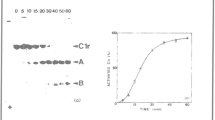Summary
In this paper we report the case of a new Italian family with severe cross-reacting material prekallikrein deficiency (CRM−). The proposita is a 22-year-old woman referred for evaluating an extremely prolonged activated partial thromboplastin time (APTT) detected during a routine screening. No clearcut bleeding history was reported. Prekallikrein antigen and activity were not measurable. The other contact-phase factors were within the normal range. Using an electromechanical coagulometer, six different commercial reagents yielded a markedly prolonged APTT (ratio>2). By prolonging the incubation time up to 10 min, APTT was normalized only with reagents employing ellagic acid as activator. On the contrary, APTT remained markedly prolonged using particulate activators (i.e. micronized silica and celite). No differences were observed using either rabbit or bovine brain cephalin. APTT was also performed on a laser automated ACL instrument; in this case reagents using ellagic acid yielded only moderately prolonged APTT values (ratio 1.3vs 1.4). The intrinsic fibrinolytic activity, as assessed by blood activator inventory test, was found to be moderately reduced (about 50% of normal) in the proposita, whereas normal values were measured in the heterozygous relatives. After infusion of 0.3 µg/kg 1-desamino-8-D-arginine vasopressin (DDAVP), kallikrein levels did not change in the proposita and her heterozygous relatives. A normal release of tissue-plasminogen activator, as assessed by fibrin-plate assay, was observed in all family members including the proposita.
Similar content being viewed by others
References
Abildgaard C. F., Harrison J.: Fletcher factor deficiency: family study and detection — Blood43, 641, 1974.
Bouma B. N., Kerbiriou D. M., Baker J., Griffin J. H.: Characterization of a variant prekallikrein, prekallikrein Long Beach, from a family with mixed cross-reacting material-positive and cross-reacting material-negative prekallikrein deficiency — J. clin. Invest.78, 170, 1986.
Colla G., Carrea M., Sbaffi A.: Fletcher factor deficiency. (Report of a new case) — La Ricerca Clin. Lab.13, 443, 1983.
Currimbhoy Z., Vinciguerra V., Palakavongs P., Kuslansky P., Degnan T. J.: Fletcher factor deficiency and myocardial infarction — Amer. J. clin. Pathol.65, 970, 1976.
Entes K., LaDuca F. M., Tourbaf K. D.: Fletcher factor deficiency, source of variations of the activated partial thromboplastin time test — Amer. J. clin. Pathol.75, 626, 1981.
Estelles A., Aznar J., Espana F.: The absence of release of the plasminogen activator after venous occlusion in a Fletcher trait patient — Thrombos. Haemostas.49, 66, 1983.
Goodnough L. T., Saito H., Ratnoff O. D.: Thrombosis or myocardial infarction in congenital clotting factor abnormalities and chronic thrombocytopenias: a report of 21 patients and a review of 50 previously reported cases — Medicine (Baltimore)62, 248, 1983.
Hathaway W. E.: Correspondence — Blood46, 817, 1975.
Hathaway W. E., Belhasen L. P., Hathaway H. S.: Evidence for a new plasma thromboplastin factor. I. Case report: coagulation studies and physicochemical properties — Blood26, 521, 1965.
Kluft C.: Studies of the fibrinolytic system in human plasma: quantitative determinations of plasminogen activators and proactivators — Thrombos. Haemostas.41, 365, 1979.
Kyrle P. A., Niessner H., Deutsch E., Lechner K., Korninger C., Mannhalter C.: CRM+ severe Fletcher factor deficiency associated with Graves’ disease — Haemostasis14, 302, 1984.
Pedersen J. T., Lee G., Chen J. M., Rapiejko J. A., Pincus M. R.: Prekallikrein sensitivity of various APTT reagents — Blood72 (Suppl. 1), 306a, 1988.
Rodeghiero F., Castaman G., Dini E.: Epidemiological investigation of the prevalence of von Willebrand’s disease — Blood69, 454, 1987.
Rodeghiero F., Castaman G., Tosetto A.: (Submitted for publication).
Saito H.: Contact factors in health and disease — Semin. Thrombos. Haemostas.13, 36, 1987.
Sollo G. D., Saleem A.: Prekallikrein (Fletcher factor) deficiency — Ann. clin. lab. Sci.15, 279, 1987.
Author information
Authors and Affiliations
Rights and permissions
About this article
Cite this article
Castaman, G., Ruggeri, M. & Rodeghiero, F. A new Italian family with severe prekallikrein deficiency. Desmopressin-induced fibrinolysis and coagulation changes in homozygous and heterozygous members. La Ricerca in Clin. Lab. 20, 239–244 (1990). https://doi.org/10.1007/BF02900708
Accepted:
Issue Date:
DOI: https://doi.org/10.1007/BF02900708




